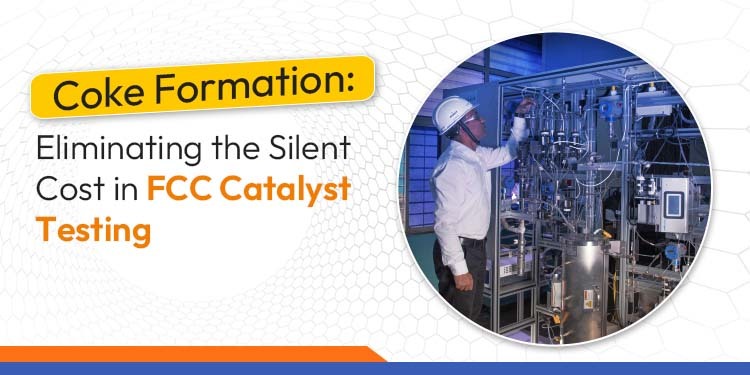Premier Pilot Plant People

Coke Formation: Eliminating the Silent Cost in FCC Catalyst Testing
Fluid Catalytic Cracking (FCC) is a core process in refining, enabling the conversion of heavy hydrocarbons into gasoline, diesel, and other lighter products. One of the persistent challenges in FCC operations is coke formation on catalysts, which reduces their effectiveness and increases operational costs. Accurate evaluation of catalyst performance under conditions that closely simulate actual FCC units is essential to address this challenge.Understanding Coke Formation in FCC
Coke is a carbon-rich deposit that forms on catalyst surfaces during hydrocarbon cracking. It results from a combination of reactions, including dehydrogenation, polymerization, and hydrogen transfer, often influenced by the Lewis acidity of the catalyst. The accumulation of coke has several effects on FCC operations:- Catalyst Deactivation: Active sites on the catalyst surface are blocked, reducing overall activity.
- Increased Regeneration Frequency: The catalyst requires more frequent regeneration, consuming energy and resources.
- Shifted Product Distribution: High coke levels can reduce yields of desired products such as gasoline and light olefins.
Limitations of Conventional Testing Methods
The Microactivity Test (MAT) is widely used to assess FCC catalyst performance. Standardized by ASTM, MAT involves passing a feed over a heated catalyst and analyzing the products to determine activity and selectivity. While MAT provides important information, it has limitations in replicating real FCC operations:- Sample Size and Scale: Small catalyst samples are used, which may not represent the full-scale reactor behavior.
- Simplified Conditions: Reaction conditions in the MAT are controlled but do not capture the dynamics of an operating FCC unit.
- Limited Regeneration Simulation: MAT may not fully replicate the impact of repeated regeneration cycles on coke deposition and catalyst activity.
XY-MAT for Accurate Catalyst Testing
XY-MAT is an automated FCC catalyst testing unit designed to simulate the steps of an FCC operation. The system integrates several critical features to provide a more accurate representation of catalyst behavior:- Automated Test Cycles: Includes steps such as catalyst loading, nitrogen purging, liquid feed injection, catalyst regeneration, and withdrawal.
- Modular Configuration: Allows adjustments to suit various test requirements.
- Temperature Control: Maintains consistent reaction conditions.
- Real-Time Data Monitoring: Tracks catalyst performance and product formation throughout the test cycle.
- Safety Features: Incorporates gas detection and interlocks to ensure safe operation.
- Scalability: Can be applied in laboratory or pilot plant settings.
Studying Coke Formation with XY-MAT
XY-MAT provides insights into coke deposition and its impact on catalyst performance. Testing with this system allows:- Monitoring Coke Accumulation: Tracks the rate and amount of coke formation under different feeds and operating conditions.
- Assessing Catalyst Deactivation: Measures changes in catalyst activity and selectivity over time.
- Evaluating Regeneration Efficiency: Determines optimal regeneration cycles to maintain performance while reducing coke impact.
- Analyzing Product Yields: Identifies the conditions that maximize desired outputs while minimizing unwanted coke formation.
Implications for Refining Operations
Accurate evaluation of coke formation and catalyst behavior has direct implications for refinery efficiency. Understanding how coke forms and how it impacts activity and product distribution allows for:- Optimized catalyst formulations.
- Reduced operational interruptions due to excessive coke.
- Improved energy utilization in regeneration cycles.
- Enhanced yield of targeted products such as gasoline, diesel, and light olefins.
Conclusion
Coke formation in FCC units affects catalyst performance, operational efficiency, and product distribution. Conventional testing methods provide useful information but often fail to replicate real-world conditions fully. Testing systems that simulate actual FCC operations allow for a detailed understanding of coke deposition, catalyst deactivation, and product yields. Incorporating realistic testing protocols into catalyst evaluation helps refine operations to maintain consistent output, manage coke-related costs, and improve overall process efficiency.Get in Touch
You will be amazed as how partnering with us becomes a game changer in your quest for R&D glory.

 Call Us
Call Us